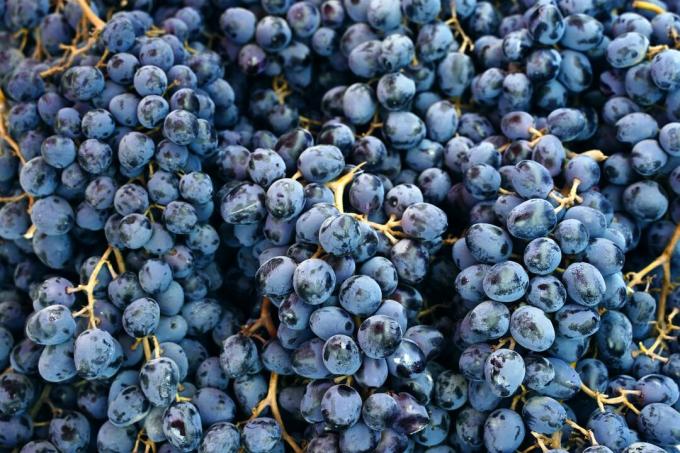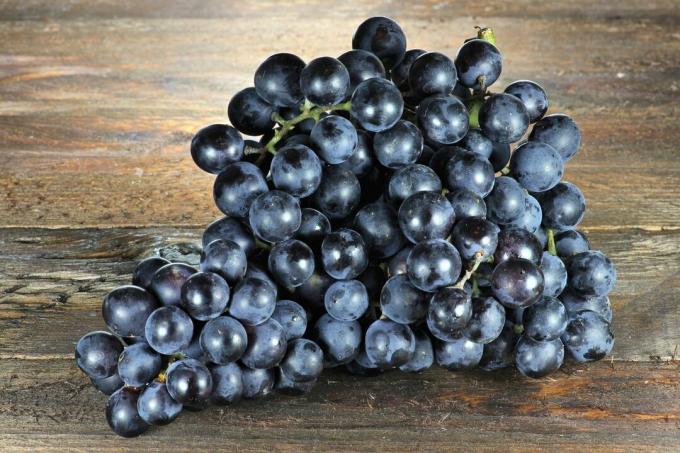The Muscat Bleu ’grape variety is one of the most popular blue table grapes. In our article we show how you can grow and harvest Muscat Bleu grapes yourself.

The name Vitis ‘Muscat Bleu’ describes this popular table grape very well: The intense blue berries enchant with a strong Muscat aroma. We will show you how you can cultivate the robust grape variety ‘Muscat Bleu’ in your garden.
contents
- Muscat Bleu: Wanted poster
- Origin and history of the table grape
- Taste and characteristics of the ‘Muscat Bleu’ grape variety
- Special features of the cultivation and care of ‘Muscat Bleu’
- Harvest and use Muscat Bleu grapes
Muscat Bleu: Wanted poster
| fruit | Table grape; great; blue |
| taste | sweet, muscat flavor |
| Harvest time | early |
| Vigor | strong |
| climate | sunny, warm; also suitable for cool regions |
| Diseases and pests | little susceptible to gray mold, good tolerance to powdery mildew |
| Sensitivity to frost | small amount |
Origin and history of the table grape
The Muscat Bleu ’grape variety is ideal for fresh consumption and is therefore one of the table grapes, which are sometimes also referred to as grapes. The ‘Muscat Bleu’ is a new breed from Switzerland. The grape breeder Garnier crossed the variety Garnier 15/6 with Seyve-Villard 20-347 in the 1930s. The Muscat Bleu ’variety is referred to as a hybrid, as not only the genome of the European grapevine (Vitis vinifera), but also the genome of other grapevine species. This is a popular method in breeding to cross-breed resistance to fungi. The table grape ‘Muscat Bleu’ is sometimes also referred to as Blue Muscat ’. This name is misleading, however, as there is already a historical grape variety with this name. The naming of grape varieties is sometimes not entirely clear.
Taste and characteristics of the ‘Muscat Bleu’ grape variety
Powdery mildew (Erysiphe necator) and downy mildew (Plasmopara viticola) the two most common diseases. The ‘Muscat Bleu’ grape variety shows good tolerance to powdery mildew and downy mildew. In addition, the variety has a good frost resistance down to about -20 ° C. ‘Muscat Bleu’ offers grapes with low-seeded, large berries that have a pleasant sweetness and an excellent Muscat aroma. The berries form large, loose grapes that are less susceptible to gray mold infestation (Botrytis cinerea) are.

Special features of the cultivation and care of ‘Muscat Bleu’
What does a suitable location for a table grape look like? The ideal place for the ‘Muscat Bleu’ variety is sunny, warm and has sufficient air movement. Vines are not very demanding in terms of soil quality and soil nutrient content. If you want to grow the vine in a very chalky soil with a high pH, you should It is essential to place them on a lime-tolerant base, such as ‘1103 Paulsen’, ‘125 AA’ or ‘140 Ruggeri’, respect, think highly of. ‘1103 Paulsen’ and ‘140 Ruggeri’ are also very well suited for dry locations, while 125 AA ’, on the other hand, are especially suitable for compacted and therefore less aerated soils.
You can find out how to properly plant your Muscat Bleu vine in our special article on the subject Planting grapevines. Grapevines should only be planted if a suitable location is available. Powdery mildew, gray mold and other diseases are very common in places that are too cool, shady and damp or in places without air movement.
For those inquisitive: vine grafting
Table grapes such as ‘Muscat Bleu’ are always offered for sale as refined plants. But what actually is a refinement and why is it necessary? The process of grafting means that a vine serves as a so-called base. The vine is cut off at the top and the so-called Edelreiser - here ‘Muscat Bleu’ - placed on it and fixed in such a way that the two plants grow together. The result is a plant that combines a resilient and strong root with good fruit properties.
The vine grafting is necessary because the roots of the rootstock protect against phylloxera introduced from North America (Daktulosphaira vitifoliae) are tolerant. The European grape varieties such as ‘Muscat Bleu’, on the other hand, are not tolerant. The vigor of a grafted vine does not only depend on the noble rice, but also on the rootstock. The table grape Muscat Bleu ’tends to be a vigorous variety. Which underlay is used is not only relevant in terms of vigor. There are documents that are adapted to specific locations; for example, documents can be particularly drought-stress-tolerant or lime-tolerant.

A climbing aid and an annual step backwards are important if you are going to use your ‘Muscat Bleu’ for many years and want lots of grapes. In spring you can cut the vine back to a few buds per shoot. There are a variety of cuts, these are called educational systems. The overhead training as a pergola offers good sun protection to avoid sunburn on the grapes. In addition, the ripe grapes can be easily harvested in this way.
Although vines have a very low nutrient requirement, annual fertilization in spring is still recommended. Here you should pay attention to a good supply of magnesium. We recommend that you use a predominantly organic fertilizer with a good long-term effect. Avoid mineral fertilizers containing chloride, as the vine cannot tolerate this. Our Plantura organic tomato fertilizer not only supplies your vine with nitrogen, phosphorus and potassium, but also with magnesium. The organic tomato fertilizer is a predominantly organic fertilizer with a long-term effect of over three months. More tips on Fertilizing grapevines you can find out in our special article.
Harvest and use Muscat Bleu grapes
The ‘Muscat Bleu’ is an early-ripening variety. The deep blue grapes can be harvested from the beginning of September, depending on the location. Therefore the ‘Muscat Bleu’ is also suitable for cultivation in cool regions. In October the leaves of the ‘Muscat Bleu’ turn bright yellow and decorate your autumn garden. So that you don't have to share your harvest with uninvited guests, our special article tells you how to Protect grapes from wasps and birds can.
The low-seed grapes are ideal for fresh consumption. You can also squeeze the grapes and process them into a juice or delicious jelly. In a few regions, such as Switzerland, the ‘Muscat Bleu’ grapes are also used to make wine.
Further blue, red and white grape varieties we have compiled for you in our overview article.



